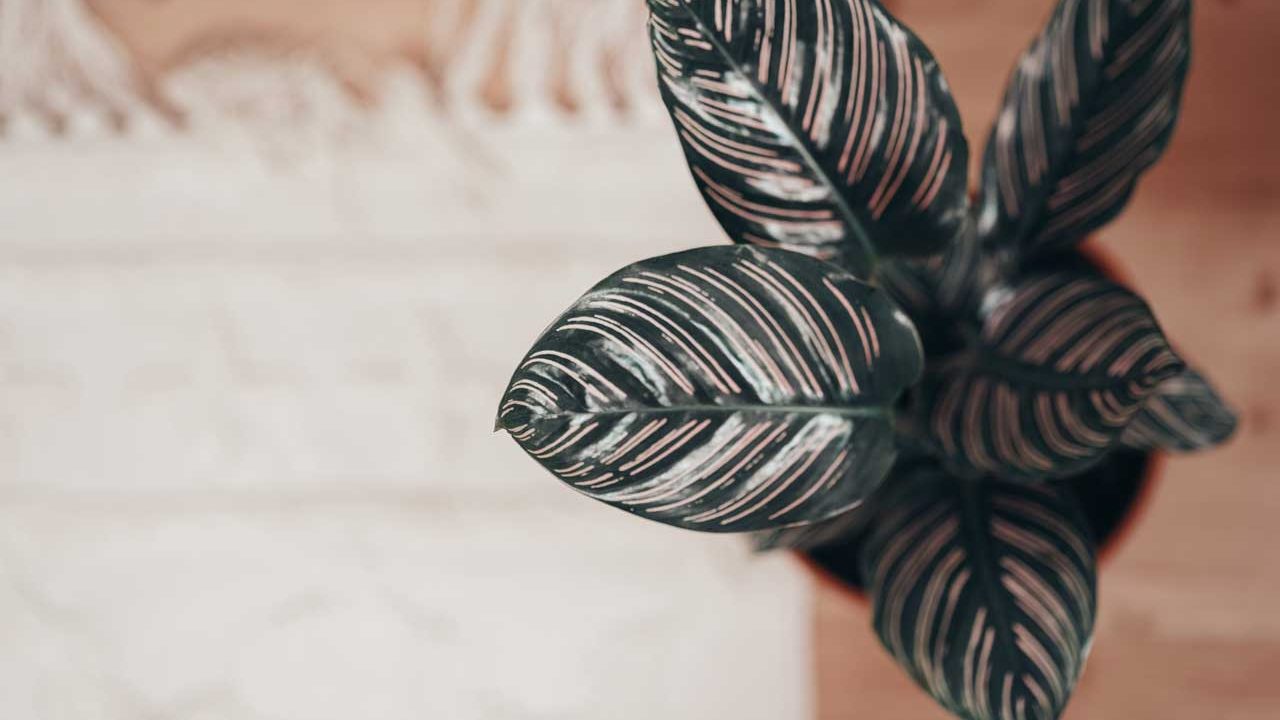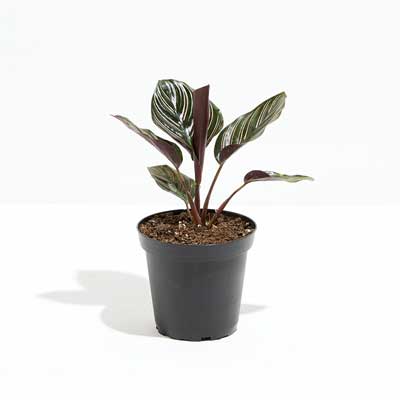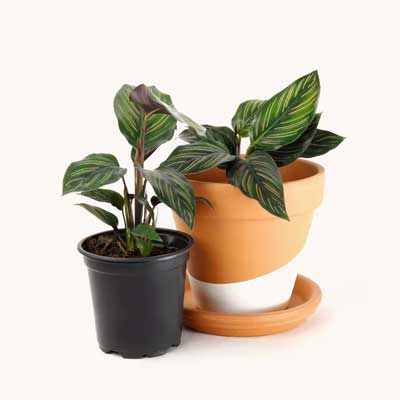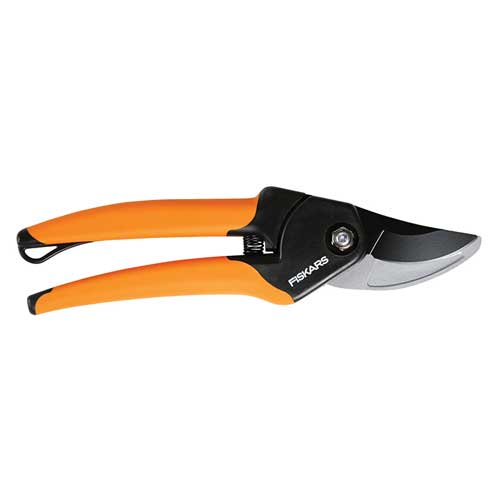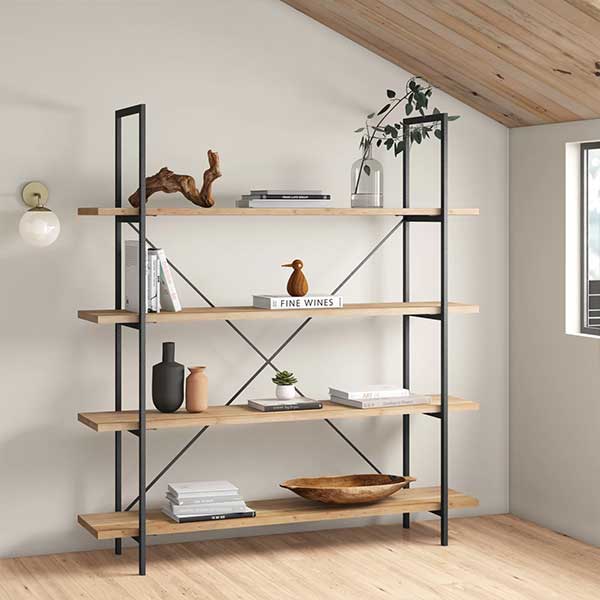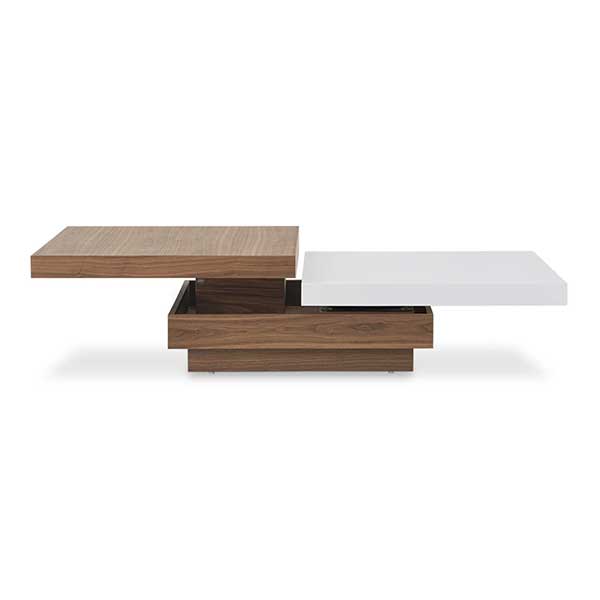Calathea Ornata Overview
Calathea Ornata, also known as the Pinstripe Plant, is a stunning tropical plant that has gained popularity among indoor plant enthusiasts. One of its most distinctive features is its dark green, glossy leaves adorned with pink stripes that run from the midrib to the margins, resembling paintbrush strokes.
Originating from South America, Calathea Ornata belongs to the Marantaceae family, known for its stunning foliage and unique daily rhythms. Like its relatives, Calathea Ornata has the ability to move its leaves in response to the time of day, a phenomenon known as nyctinasty. During the day, the leaves extend outward to catch as much light as possible, and at night, they fold upwards, showing off their purple undersides.
As an indoor plant, Calathea Ornata is highly valued for its beauty. It prefers bright, indirect light and consistently moist soil. With proper care, this plant can thrive indoors and provide a stunning addition to any home or office space.
Where to Buy Calathea Ornata
If you're looking to add Calathea Ornata to your indoor plant collection, here are some reliable places to consider:
Lively Root offers a variety of indoor and outdoor plants, including Calathea Ornata.
Walmart and Home Depot are good choices, as they offer a wide selection of plants at affordable prices.
Bloomscape, The Sill, Garden Goods Direct, Horti, and Terrain are also great options for buying Calatheas online, each offering a wide range of healthy, well-cared-for plants to choose from.
Easyplant sells Calatheas and other indoor plants in self-watering pots.
Calathea Ornata Care Tips
Caring for Calathea Ornata can be a bit challenging, but it is certainly worth the effort. By following these care tips, you can help your Calathea Ornata flourish and enjoy its beautiful striped leaves for many years.
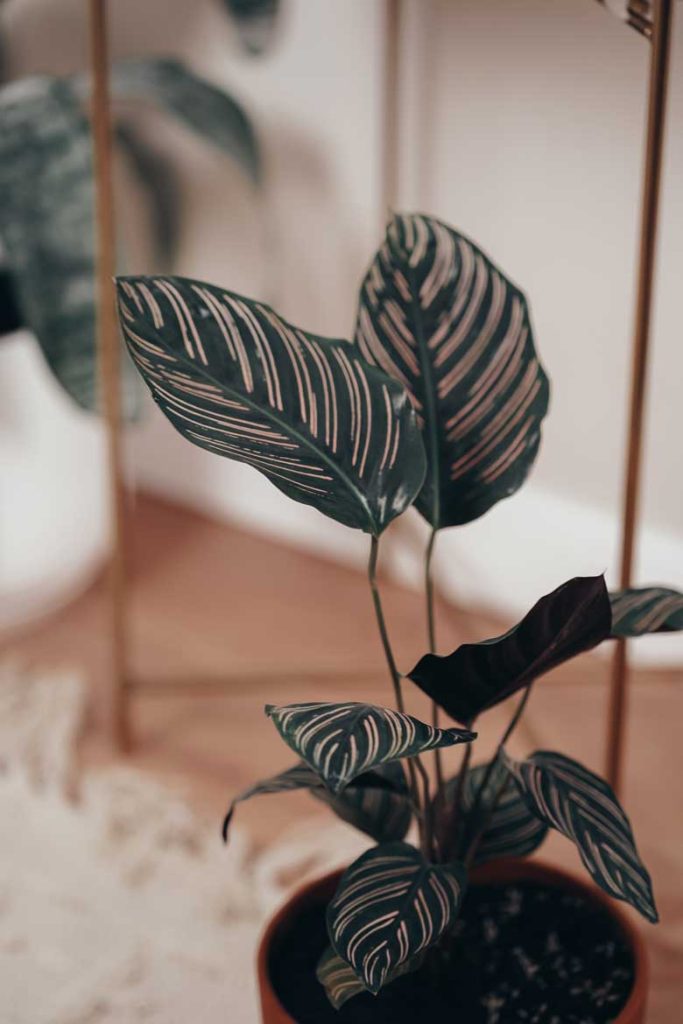
Light Requirements
Calathea Ornata prefers bright, indirect light. It's important to avoid direct sunlight as it can lead to the leaves becoming burnt or faded. Its natural habitat is in the understory of tropical forests, where it receives filtered light, so replicating this light condition is ideal for its growth indoors.
A north or east-facing window that gets plenty of light but not direct sun is ideal for this plant. If you only have a south or west-facing window, you can use a sheer curtain or blinds to diffuse the sunlight and protect your Calathea Ornata from direct exposure. Turning the plant occasionally can also help ensure that all sides of the plant receive equal amounts of light, promoting even and balanced growth.
In areas with less natural light or during the darker winter months, you can supplement the plant's light with artificial light sources. Fluorescent lights or LED grow lights can be used to provide the plant with the necessary spectrum of light it needs to thrive.
Water Requirements
Calathea Ornata prefers a consistently moist environment but is sensitive to overwatering. To maintain the right level of moisture, water it when the top inch of the soil feels dry to the touch. When watering, use lukewarm water rather than cold water to avoid shocking the plant's roots. Additionally, Calathea Ornata is sensitive to chemicals often found in tap water, such as chlorine. To avoid leaf browning, use filtered, distilled, or rainwater.
During warmer months, it may require more frequent watering. In contrast, during colder months, the plant's water requirements may decrease. It's crucial to adjust your watering schedule based on seasonal changes and the plant's needs.
If you're uncertain about when to water your Calathea Ornata, a moisture meter can be a valuable tool. Moisture meters, available in both digital and analog versions, allow you to measure the moisture content in the soil and prevent over or under-watering. Some moisture meters also offer additional features, such as a pH meter or light meter, useful for monitoring other aspects of your plant's environment.
There are many different types of moisture meters available, including digital and analog options. Some moisture meters may also include additional features, such as a pH meter or light meter, which can be useful for monitoring other aspects of your plant's environment.
To use a moisture meter, insert the probe into the soil (about 3 quarters deep into the pot). Then, check the moisture level on the meter. A low reading indicates it's time to water your plant, while a high reading suggests waiting a few more days before the next watering.
Besides using a moisture meter or manually checking the soil, look out for other signs your Calathea Ornata may need water. For instance, drooping or curling leaves or a lighter plant weight can indicate the need for watering. However, it's best to water before these signs appear to avoid stressing or damaging the plant.
Temperature Requirements
Calathea Ornata, like most tropical plants, prefers a warm and consistent temperature range to thrive. The ideal temperature range for this plant is between 65°F (18°C) to 85°F (29°C). It can tolerate a slight dip below this range, but prolonged exposure to temperatures below 60°F (15°C) can lead to leaf curling and other signs of stress.
Keep in mind that this plant does not tolerate cold drafts well. Therefore, keep it away from drafty windows, doors, or air conditioning units that might expose it to cold air. Similarly, it should also be shielded from heaters or heat vents, as these can dry out the plant and cause leaf damage.
If you're unsure about the temperature and humidity in your space, use a digital thermometer to monitor the area where you've placed your Calathea Ornata.
Humidity Requirements
This tropical plant loves high humidity levels of around 50% and above. To maintain adequate humidity levels for your Calathea Ornata, there are several strategies you can try.
One option is to place the plant on a tray with moist pebbles. Choose a tray that is slightly larger than your Calathea Ornata's pot. Fill this tray with small pebbles or stones and pour in water until it nearly covers the pebbles. Position your Calathea Ornata on the pebbles, ensuring the pot does not directly touch the water. This setup promotes evaporation, generating a humid microclimate encompassing your plant.
A humidifier can be another effective means to increase humidity levels. This method is particularly useful in dry environments or during winter.
Levoit Smart Warm and Cool Mist Humidifier
6L Top Fill Air Vaporizer for Large Rooms, LV600s, White
You can also mist the leaves of your Calathea Ornata to enhance the humidity. However, avoid excessive misting as it might result in the growth of fungi or bacteria. While misting can be helpful, it isn't necessarily the best option.
Grouping your Calathea Ornata with other plants that enjoy high humidity can also create a microclimate with increased moisture levels, which all the plants will appreciate. Besides, clustering plants together will look beautiful in your living space.
Soil Requirements
Calathea Ornata prefers a well-aerated, slightly acidic soil with a pH between 6.0 and 7.0. A perfect blend consists of equal parts peat, perlite, and orchid bark. Peat is beneficial for holding onto moisture, which is crucial for the plant's growth and health. Perlite and orchid bark provide good drainage and aeration, preventing the soil from retaining excessive water and reducing the risk of root rot.
If you want to create your own soil blend, you can mix equal amounts of peat, perlite, and orchid bark. Alternatively, you can buy a pre-made soil mix specifically designed for tropical plants like Calathea Ornata.
Some pre-made soil mixes suitable for Calathea Ornata are:
- Miracle-Gro Indoor Potting Mix
- Fox Farm Ocean Forest Potting Soil
- Espoma Organic Potting Mix
- Sun Gro Black Gold Natural & Organic Potting Soil
When selecting a soil mix for your Calathea Ornata, check the ingredients on the package to ensure that it provides the right balance of nutrients, drainage, and aeration for the plant.
Fertilizing Calathea Ornata
During the active growth phase of your Calathea Ornata, which typically occurs in spring and summer, fertilize the plant every 4-6 weeks. Choose a balanced, water-soluble fertilizer and dilute it to half its recommended strength. Before applying the fertilizer, water the plant thoroughly. This ensures even dispersion and absorption of the nutrients by the roots. After fertilizing, water the plant again to prevent fertilizer burn and aid in distributing the nutrients throughout the soil.
Reduce fertilizing during the winter months, as the plant's growth slows down. This will help prevent over-fertilization, which can lead to salt buildup in the soil and potentially damage the plant's roots.
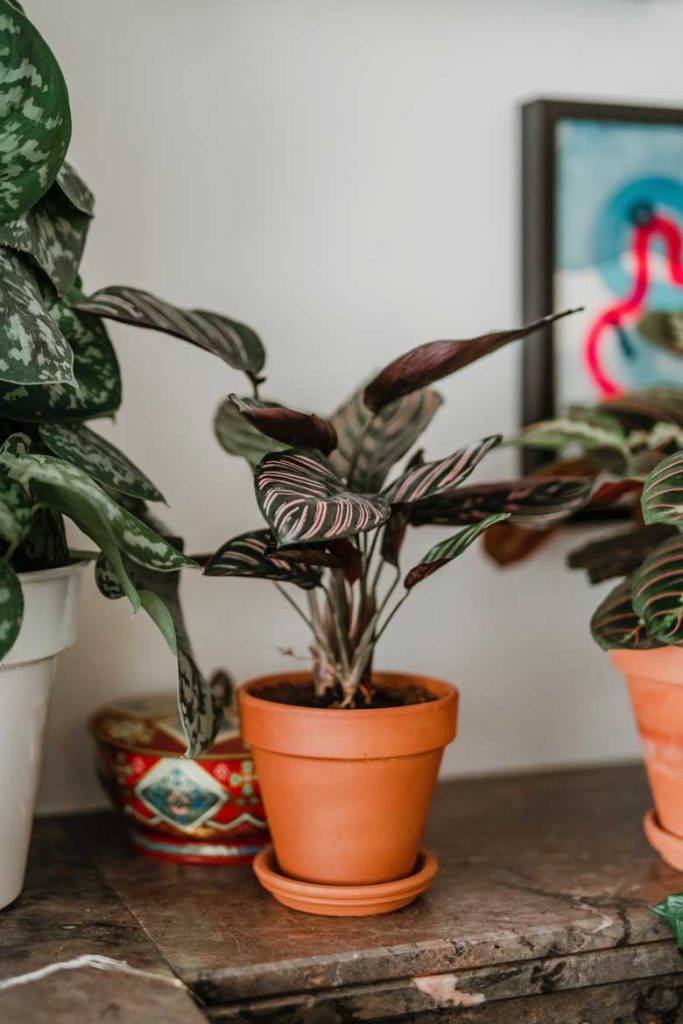
Pruning
Regularly removing dead or yellowing leaves from your Calathea Ornata promotes fresh growth and keeps the plant healthy. Use sterilized scissors or pruning shears to make clean cuts at the stem base. This not only improves the plant's appearance but also prevents the spread of disease and pests.
Avoid over-pruning as it can shock the plant and hinder growth. Instead, only remove dead or yellow leaves as required, typically one or two at a time. This will allow the plant to adjust to the changes and continue to grow.
In addition to removing dead or yellowing leaves, keep an eye out for any signs of pest infestations or disease. Signs of pest infestations include tiny webs, white or gray powdery residue, and small bumps on the leaves or stems. If you notice any of these signs, it is important to take action promptly to prevent further damage and spread of the pests.
Fiskars Bypass Pruner Garden Tool with Steel Blade and SoftGrip Handle
Fully hardened, precision-ground steel blade
Repotting Calathea Ornata
Repot your Calathea Ornata every 1-2 years, or when you notice the roots beginning to outgrow the pot. This not only provides the plant with more room to grow but also replenishes the soil's nutrients.
When it's time to repot, choose a new pot that's about 1-2 inches larger in diameter than the current one. This gives the plant enough room to grow but doesn't overwhelm it with too much soil. The pot should have drainage holes to avoid water retention, a common cause of root rot.
Begin repotting by gently taking out the plant from the old pot, being cautious not to harm the roots. Inspect the roots for any signs of disease or damage. They should be light brown/white and firm. If you see any roots that are black or look spongy you should remove them.
Next, fill the first third of the new pot with soil, place the plant and add fresh potting mix around it. Once the soil is filled in, gently press it down to ensure the plant is stable.
Finally, water the plant thoroughly to help the soil settle. Position the repotted plant in a warm, well-lit spot away from direct sunlight or drafts. Monitor its health and watering needs for the next few weeks to ensure it is adjusting to its new pot and soil.
Propagating Calathea Ornata
Calathea Ornata propagates through division, meaning you'll need to divide its root system to create new plants. Start by removing the entire plant from its pot and gently shaking off any excess soil. Inspect the roots and locate natural divisions in the root ball.
Using clean, sharp scissors or a knife, cut through the roots to create separate sections. Each section should have a healthy portion of roots and at least one or two leaves. Replant the divisions in fresh soil, water thoroughly and place them in a warm, well-lit area, away from direct sunlight to help them establish their root systems.
Common Calathea Ornata Problems
Root Rot
Overwatering or soil that doesn't drain properly can pose serious threats to the health of your Calathea Ornata and may lead to root rot. Root rot is a fungal condition that appears when the roots are consistently exposed to excess moisture. If you notice a foul smell or mushy, black roots, your plant may have root rot.
To treat root rot in Calathea Ornata, take out the plant from the pot and remove the affected roots. Use sterilized scissors or pruning shears to make clean cuts and avoid further damage to the plant. After pruning, repot the plant in fresh potting soil, preferably one that drains well. The new pot should have drainage holes to prevent water from sitting at the bottom.
To prevent the recurrence of root rot, adjust your watering routine. Calathea Ornata prefers its soil to be kept slightly moist but not waterlogged. Allow the top inch of soil to dry out between waterings.
Pests
Calathea Ornata is susceptible to pests like spider mites, thrips, mealybugs, and aphids, which can cause significant damage to the plant if left untreated.
Spider mites are tiny arachnids that can cause fine webbing on the leaves of Calathea Ornata, as well as yellowing and browning of the leaves. Thrips are small, slender insects that can cause silvery or brownish streaks on the leaves, as well as distorted growth. Mealybugs are soft-bodied insects that can cause white, cottony masses on the leaves and stems, as well as stunted growth. Aphids are small, pear-shaped insects that can cause curling or distortion of the leaves, as well as sticky sap on the plant.
These pests can be difficult to detect, so you should check the plant regularly for signs of infestation. Look for fine webbing, white or cottony masses, silvery or brownish streaks, or curling or distortion of the leaves. If you notice any of these signs, take action promptly to prevent further damage and spread of the pests.
To treat pest infestations in Calathea Ornata, you can use natural remedies like insecticidal soap or neem oil. These remedies are effective at killing pests while being safe for the plant and the environment.
Here are some steps you can take to treat pests on your Calathea Ornata:
- Isolate the plant: If you find pests on your plant, isolate it from your other plants to prevent the pests from spreading.
- Identify the pest: Identify the pest that is affecting your plant so that you can choose the most effective treatment. Different pests may require different treatments, so it's important to know what you're dealing with.
- Clean the plant: Use a soft, damp cloth to wipe off pests or use a gentle stream of water. This can help to reduce the number of pests on the plant.
- Use natural remedies: Insecticidal soap and neem oil are effective natural remedies for treating pest infestations on Calathea Ornata. Follow the instructions on the label carefully and apply the treatment evenly to all parts of the plant, including the undersides of the leaves where pests often hide.
- Prune affected leaves: If the infestation is severe, it may be necessary to prune affected leaves to prevent the pests from spreading further.
- Monitor the plant: Monitor your Calathea regularly after treatment to ensure that the pests have been eradicated and that the plant is healthy.
There are many insecticidal soap and neem oil brands available on the market that are safe for indoor use and specifically formulated for houseplants. Here are some products we recommend:
- Bonide Insecticidal Soap: This insecticidal soap is safe for use on Calathea Ornata and other indoor plants. It is made with natural and organic ingredients, and it kills a wide range of pests including spider mites, aphids, and whiteflies.
- Garden Safe Insecticidal Soap: This insecticidal soap is safe for use on indoor plants. It's made with natural ingredients and it kills a variety of pests including aphids, spider mites, and whiteflies.
- Natria Neem Oil: This neem oil product kills a wide range of pests including spider mites, thrips, and whiteflies.
Remember to always follow the instructions on the label when using any pest treatment, and to test any new product on a small area of the plant before applying it more widely.
In addition to using natural remedies, we recommend removing any dead leaves or debris from around the plant. Dead leaves and debris can harbor pests and create a breeding ground for fungal infections, so it's best to remove them.
To prevent pest infestations, maintain proper care and hygiene for your Calathea Ornata. This includes providing adequate water and humidity, avoiding over-fertilizing, and ensuring proper air circulation around the plant.
Brown / Crispy Tips
Brown tips or edges on the leaves may indicate low humidity. Calathea Ornata prefers high humidity levels, and dry air can cause the tips and edges of the leaves to become brown and crispy. The quality of water used can also affect the plant. Calatheas are sensitive to the chemicals often found in tap water, such as chlorine and fluoride, which can cause the leaf tips to turn brown.
Yellow Leaves
One common reason for yellow leaves is overwatering. When the plant gets too much water, it can lead to root rot, which in turn can cause the leaves to turn yellow. If you notice yellowing leaves on your Calathea Ornata, it's important to adjust your care routine accordingly. First, ensure that the plant is not sitting in water, and make sure the soil is well-draining. Reduce the frequency of watering, and only water the plant when the top inch of soil feels dry to the touch.
If adjusting your care routine does not solve the issue, it may be necessary to repot the plant in fresh soil or move it to a more suitable environment.
Curled Leaves
One common cause of curled leaves in Calathea Ornata is underwatering. This plant requires consistently moist soil, and if the soil dries out too much between waterings, the plant may become stressed and start curling its leaves. In some cases, the leaves may even start to turn brown and crispy at the edges, especially if the dry soil persists for an extended period of time. Water your Calathea Ornata regularly and don't let the soil to dry out completely.
If your Calathea is exposed to cold drafts or drastic temperature changes, the leaves may curl as a defensive mechanism. Try to provide a stable, warm environment away from drafty windows or doors.
Direct sunlight can also cause curled leaves on Calathea Ornata. This plant prefers bright, indirect light but cannot tolerate direct sunlight. If the plant is placed in a spot where it receives too much direct sunlight, the leaves may start to curl and the edges may turn brown.
Clogged Pores
A build-up of dust particles on the leaves of your Calathea can have a negative impact on the plant's health and growth. As dust accumulates on the leaves, it can clog the pores, which can lower the plant's ability to capture light and perform photosynthesis. To prevent dust build-up on your Calathea Ornata, wipe the leaves once a month with a damp cloth on both sides.
In addition to improving the plant's ability to capture light, wiping down the leaves can also help to prevent pest infestations.
Transplant Shock
If you notice signs of stress after repotting your Calathea Ornata, such as wilting or dropping leaves, give it time to adjust to its new environment. Repotting can disrupt the plant's root system, and it may take some time for the roots to re-establish themselves and for the plant to recover.
To help your Calathea Ornata recover from repotting, maintain consistent care, and avoid moving the plant. This means providing it with the same amount of water and light as before and avoiding any sudden changes in temperature or humidity. Avoid fertilizing the plant for at least a month after repotting, as this can further stress the plant.
It's normal for your plant to show some signs of stress after repotting. However, if it continues to show signs of stress after a few weeks, it may be necessary to investigate further. This could include checking the soil moisture level, ensuring the plant is not receiving too much or too little light, or checking for pest infestations.
Fertilizer Burn
Over-fertilizing Calathea Ornata can cause fertilizer burn, which can lead to brown spots on the leaves.
Fertilizer burn occurs when the concentration of nutrients in the soil becomes too high, leading to an imbalance that can damage the plant. This can be caused by applying too much fertilizer at once, applying fertilizer too frequently, or using a fertilizer that is too strong for the plant's needs. When this happens, the excess salt in the fertilizer can accumulate in the soil, causing the plant to absorb more salt than it can handle. This can lead to dehydration, yellowing, and browning of the leaves, as well as stunted growth and in severe cases, death.
To avoid fertilizer burn, apply a balanced fertilizer every 4-6 weeks during the growing season and stop fertilization during the winter months when the plant is dormant. Use a fertilizer that is specifically formulated for indoor plants and dilute it to half-strength or more. Additionally, water the plant thoroughly before and after fertilization to help flush any excess salt from the soil.
If you notice brown spots on the leaves of your Calathea Ornata, you should act quickly to prevent further damage. This may involve adjusting your fertilization routine, reducing the amount of fertilizer you use, or switching to a gentler fertilizer.
Mold developing on the soil
Like all indoor plants, Calathea Ornata is susceptible to mold growth on the soil surface. Two of the most common causes of mold growth on the soil surface of Calathea Ornata are too little light and over-watering.
When Calathea Ornata does not receive enough light, it can result in a buildup of moisture on the soil surface, creating an environment that is conducive to mold growth. To prevent mold growth due to insufficient light, place the plant in a spot with bright, indirect light. Supplementing with artificial light can also be helpful.
Secondly, over-watering is another common cause of mold growth on the soil surface of Calathea Ornata. When the soil is watered too frequently or is not allowed to dry out between waterings, it can become waterlogged, resulting in a buildup of moisture on the soil surface. This excess moisture, along with the organic matter in the soil, can create an ideal environment for mold growth. To prevent mold growth due to over-watering, water the plant only when the top inch of the soil feels dry to the touch.
Mold growth on the soil surface of Calathea Ornata does not necessarily mean that the plant is unhealthy. However, the presence of mold along with yellowing lower leaves could indicate root rot.
Styling Calathea Ornata
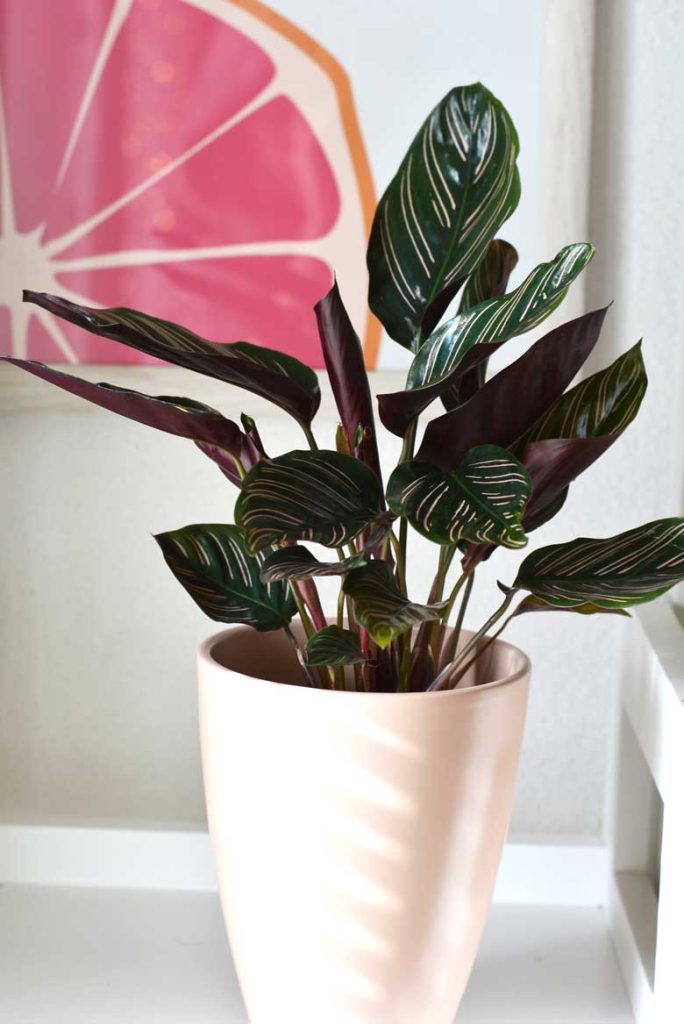
Styling your Calathea Ornata is an excellent way to showcase its unique beauty and add a touch of greenery to your home or office space. This stunning plant can be styled in a variety of ways, depending on your decor and personal style.
One popular way to style Calathea Ornata is to place it on a plant stand or pedestal, which can elevate the plant and make it a focal point in the room. Alternatively, you can group several Calatheas together to create a lush and tropical display.
Another option is to pair Calathea Ornata with other plants with contrasting textures and colors. For example, combining it with a trailing plant such as a Pothos or a hanging plant such as a String of Pearls can create a beautiful and dynamic display.
When it comes to containers, cover pots can be used to add an extra layer of style and functionality to your Calathea Ornata. Cover pots can be made from a variety of materials, including ceramic, terra cotta, or metal, and come in a range of sizes and styles to match your decor. You can find beautiful cover pots at Food52, The Sill, Bloomscape, and Wayfair.
Overall, Calathea Ornata is a lovely and unique houseplant that can add a touch of tropical elegance to any home. With proper care and attention, this plant can thrive and continue to delight its owners with its stunning appearance and natural movements.
Read next: How to Grow and Care for Calathea Orbifolia
